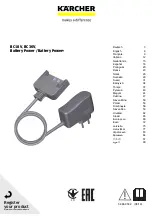
BATTERY TYPE BUTTON
Use this button to select the battery type.
Standard
–
Used in cars, trucks and motorcycles, these batteries have vent caps and are often marked “low
maintenance” or “maintenance-free”. This type of battery is designed to deliver quick bursts of energy (such as starting
engines) and has a greater plate count. The plates are thinner and have somewhat different material composition.
Standard batteries should not be used for deep-cycle applications.
AGM
–
The Absorbed Glass Mat construction allows the electrolyte to be suspended in close proximity with
the plate’s
active material. In theory, this enhances both the discharge and recharge efficiency. The AGM batteries are a variant of
Sealed VRLA (valve regulated lead-acid) batteries. Popular uses include high-performance engine starting, power
sports, deep-cycle, solar and storage batteries.
GEL
–
The electrolyte in a GEL cell has a silica additive that causes it to set up or stiffen. The recharge voltages on this
type of cell are lower than those for other styles of lead-acid battery. This is probably the most sensitive cell in terms of
adverse reactions to overvoltage charging. Gel batteries are best used in VERY DEEP cycle application and may last a
bit longer in hot weather applications. If the wrong battery charger is used on a gel cell battery, poor performance and
premature failure will result.
11. OPERATING INSTRUCTIONS
WARNING: A SPARK NEAR THE BATTERY MAY CAUSE AN EXPLOSION.
IMPORTANT
: Do not start the vehicle with the charger connected to the AC outlet, or it could result in damage to the
charger and your vehicle.
NOTE:
This charger is equipped with an auto-start feature. Current will not be supplied to the battery clamps until a
battery is properly connected. The clamps will not spark if touched together.
CHARGING A BATTERY IN THE VEHICLE
1.
Turn off all the vehicle’s accessories.
2.
Keep the hood open.
3.
Clean the battery terminals.
4.
Place the charger on a dry, non-flammable surface.
5.
Lay the AC/DC cables away from any fan blades, belts, pulleys and other moving parts.
6.
Connect the battery, following the precautions listed in sections 6 and 7.
7.
Connect the charger to a live grounded AC outlet.
8.
Select the battery type and charge rate.
9.
Charging will begin within ten minutes and finish automatically. (Press the START/STOP button to begin
charging immediately.)
10.
When charging is complete, disconnect the charger from the AC power, remove the clamp from the
vehicle’s chassis, and then remove the clamp from the battery terminal.
CHARGING A BATTERY OUTSIDE OF THE VEHICLE
1.
Place battery in a well-ventilated area.
2.
Clean the battery terminals.
3.
Connect the battery, following the precautions listed in sections 6 and 7.
4.
Connect the charger to a live grounded AC outlet.
5.
Select the battery type and charge rate.
6.
Charging will begin within ten minutes and finish automatically. (Press the START/STOP button to begin
charging immediately.)
7.
When charging is complete, disconnect the charger from the AC power, disconnect the negative clamp, and
finally the positive clamp.
8.
A marine (boat) battery must be removed and charged on shore.
AUTOMATIC CHARGING MODE
When an Automatic Charge is performed, the charger switches to the maintain mode automatically after the battery is
charged.
1-800-345-4545 jegs.com


























